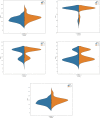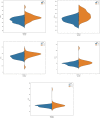Balance performance, falls-efficacy and social participation in patients with type 2 diabetes mellitus with and without vestibular dysfunction
- PMID: 38766481
- PMCID: PMC11102735
- DOI: 10.7717/peerj.17287
Balance performance, falls-efficacy and social participation in patients with type 2 diabetes mellitus with and without vestibular dysfunction
Abstract
Background: The performance of balance is an important factor to perform activities. The complications of type 2 diabetes mellitus (T2DM), especially vestibular dysfunction (VD), could decrease balance performance and falls-efficacy (FE) which consequently impacts social participation and quality of life (QoL).
Purpose: This study aimed to compare balance performance, FE, social participation and QoL between individuals with T2DM with and without VD.
Methods: The participants comprised 161 T2DM with VD and 161 without VD. Three clinical tests used for confirming VD included the Head Impulse Test (HIT), the Dix Hallpike Test (DHT) and the Supine Roll Test (SRT). The scores of static and dynamic balances, FE, social participation and QoL were compared between groups.
Results: The balance performance, FE, social participation and QoL were lower in the group with VD. The number of patients who had severe social restriction was higher in T2DM with VD than without VD (58.4% vs 48.4%). Moreover, all domains of QoL (physical, psychological, social relationships and environmental) were lower in T2DM with VD than without VD.
Conclusion: The presence of VD in T2DM patients was associated with decreased physical balance performances and increased social and QoL disengagement. Comprehensive management related to balance and FE, as well as the monitoring to support social participation and QoL, should be emphasized in patients with T2DM with VD.
Keywords: Falls-efficacy; Quality of life; Social participation; Type 2 diabetes mellitus; Vestibular dysfunction; Balance performance.
©2024 Komalasari et al.
Conflict of interest statement
The authors declare there are no competing interests.
Figures
Similar articles
-
The Adaptation of Participation Scale Short Simplified Questionnaire into Indonesian Language and the Psychometric Properties in Individuals with Type 2 Diabetes Mellitus with Vestibular Dysfunction.Rehabil Res Pract. 2022 Jun 15;2022:2565833. doi: 10.1155/2022/2565833. eCollection 2022. Rehabil Res Pract. 2022. PMID: 35756573 Free PMC article.
-
Impairment of Vestibular Function and Balance Control in Patients with Type 2 Diabetes.Audiol Neurootol. 2019;24(3):154-160. doi: 10.1159/000501291. Epub 2019 Jul 19. Audiol Neurootol. 2019. PMID: 31326970
-
Impact of Diabetic Complications on Balance and Falls: Contribution of the Vestibular System.Phys Ther. 2016 Mar;96(3):400-9. doi: 10.2522/ptj.20140604. Epub 2015 Aug 6. Phys Ther. 2016. PMID: 26251477 Free PMC article. Review.
-
Control Mechanisms of Static and Dynamic Balance in Adults With and Without Vestibular Dysfunction in Oculus Virtual Environments.PM R. 2018 Nov;10(11):1223-1236.e2. doi: 10.1016/j.pmrj.2018.07.001. PM R. 2018. PMID: 30503230 Clinical Trial.
-
Assessment of vestibular function in elderly patients.Curr Opin Otolaryngol Head Neck Surg. 2018 Oct;26(5):302-306. doi: 10.1097/MOO.0000000000000476. Curr Opin Otolaryngol Head Neck Surg. 2018. PMID: 30028746 Review.
Cited by
-
Predictors of Quality of Life Among Older Residents in Rural and Urban Areas in Indonesia: An Approach Using the International Classification of Functioning, Disability, and Health.J Prev Med Public Health. 2025 Mar;58(2):199-207. doi: 10.3961/jpmph.24.423. Epub 2024 Nov 29. J Prev Med Public Health. 2025. PMID: 39638295 Free PMC article.
-
Effects of Exercise on Dynamic Balance in People with Type 2 Diabetes Mellitus: A Systematic Review and Meta-Analysis of Randomized Controlled Trials.Life (Basel). 2025 Jun 4;15(6):913. doi: 10.3390/life15060913. Life (Basel). 2025. PMID: 40566565 Free PMC article. Review.
-
Sensorimotor dysfunction and postural instability in older adults with type 2 diabetes mellitus: the role of proprioception and neuropathy.Front Aging Neurosci. 2025 Jun 23;17:1615399. doi: 10.3389/fnagi.2025.1615399. eCollection 2025. Front Aging Neurosci. 2025. PMID: 40625373 Free PMC article.
References
-
- Bhardwaj V, Vats MJ. Effectiveness of gaze stability exercise on balance in healthy elderly population. International Journal of Physiotherapy and Research. 2014;2(4):642–647.
MeSH terms
LinkOut - more resources
Full Text Sources
Medical




